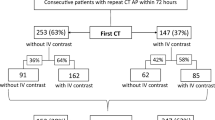Abstract
Purpose
In this study, the impact of contrast-enhanced abdominopelvic CT scan interpretations by emergency medicine team on patients’ morbidity and mortality was evaluated and their interpretations were compared to radiologists’ reports.
Methods
During a 3-month period, all patients who had undergone a contrast-enhanced abdominopelvic CT scan at the emergency department enrolled in this study. All CT scans were interpreted blindly by the emergency medicine (ED) attending physicians and the patients were treated accordingly. Radiologists reported all the CT scans within 12 h. Radiologists’ reports were put into the agreement or disagreement group retrospectively. A panel of experts further evaluated the disagreement groups’ medical charts and placed them in clinically significant or insignificant group based on the follow-up for 28 days.
Results
In this study, 170 CT scans were interpreted. The agreement rate was 68.2%. In the clinically significant disagreement group, eight patients did not receive the required treatment and three patients were over treated. Although the overall mortality rate was 5, none could have been prevented by a prompt radiologist’s report. The disagreement group had longer hospital stay (p = 0.006) and transfer to other wards (p = 0.035). The inter-rater reliability between emergency medicine attending physicians and attending radiologists was substantial (kappa = 0.77) and statistically significant (p < 0.0001).
Conclusion
Our findings support the cautious use of ED physicians’ CT scan interpretations for patients’ management. Ideally, the ED physicians should utilize a real-time radiologist interpretation in critical patients. This collaboration will result in better patient management.

Similar content being viewed by others
References
Larson DB, Johnson LW, Schnell BM, Salisbury SR, Forman HP (2011 Jan) National trends in CT use in the emergency department: 1995-2007. Radiology 258(1):164–173
Soto JA, Anderson SW (2012) Multidetector CT of blunt abdominal trauma. Radiology 265(3):678–693
Ikegami Y, Suzuki T, Nemoto C, Tsukada Y, Hasegawa A, Shimada J, Tase C (2014) Establishment and implementation of an effective rule for the interpretation of computed tomography scans by emergency physicians in blunt trauma. World J Emerg Surg 9:40
Wing VW, Federle MP, Morris JA Jr, Jeffrey RB, Bluth R (1985) The clinical impact of CT for blunt abdominal trauma. AJR Am J Roentgenol 45(6):1191–1194
Colucciello SA (1993 Feb) (1993). Blunt abdominal trauma. Emerg Med Clin North Am 11(1):107–123
Laméris W, van Randen A, Dijkgraaf MG, Bossuyt PM, Stoker J, Boermeester MA (2007) Optimization of diagnostic imaging use in patients with acute abdominal pain (OPTIMA): design and rationale. BMC Emerg Med 7:9
Gans SL, Pols MA, Stoker J, Boermeester MA (2015) Guideline for the diagnostic pathway in patients with acute abdominal pain. Dig Surg 32(1):23–31
Saketkhoo DD, Bhargavan M, Sunshine JH, Forman HP (2004) Emergency department image interpretation services at private community hospitals. Radiology 231(1):190–197 Epub 2004 Feb 27
Talebian MT, Kavandi E, Farahmand S, Shahlafar N, Arbab M, Seyedhosseini-Davarani S, Nejati A, Bagheri-Hariri S (2015) Comparing the brain CT scan interpretation of emergency medicine team with radiologists’ report and its impact on patients’ outcome. Emerg Radiol 22(3):261–268
Patterson BW, Venkatesh AK, AlKhawam L, Pang PS (2015) Abdominal computed tomography utilization and 30-day revisitation in emergency department patients presenting with abdominal pain. Acad Emerg Med 22(7):803–810
Raja AS, Mortele KJ, Hanson R, Sodickson AD, Zane R, Khorasani R (2011) Abdominal imaging utilization in the emergency department: trends over two decades. Int J Emerg Med 4:19
Sellers A, Hillman BJ, Wintermark M (2014) Survey of after-hours coverage of emergency department imaging studies by US academic radiology departments. J Am Coll Radiol 11(7):725–730
Acknowledgements
We thank all the patients who willingly participated in this study.
Author information
Authors and Affiliations
Corresponding author
Ethics declarations
The study was approved by the hospital’s board of management and ethics. After thorough explanation of the study, informed consents were collected from patients or their legal representatives.
Conflict of interest
The authors declare that they have no conflict of interest.
Rights and permissions
About this article
Cite this article
Bagheri-Hariri, S., Ayoobi-Yazdi, N., Afkar, M. et al. Abdominal and pelvic CT scan interpretation of emergency medicine physicians compared with radiologists’ report and its impact on patients’ outcome. Emerg Radiol 24, 675–680 (2017). https://doi.org/10.1007/s10140-017-1542-2
Received:
Accepted:
Published:
Issue Date:
DOI: https://doi.org/10.1007/s10140-017-1542-2




